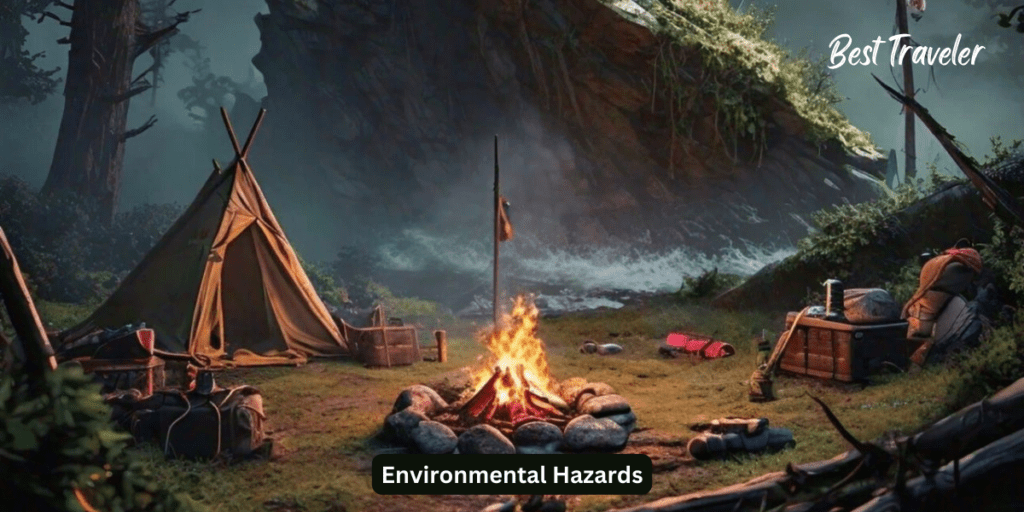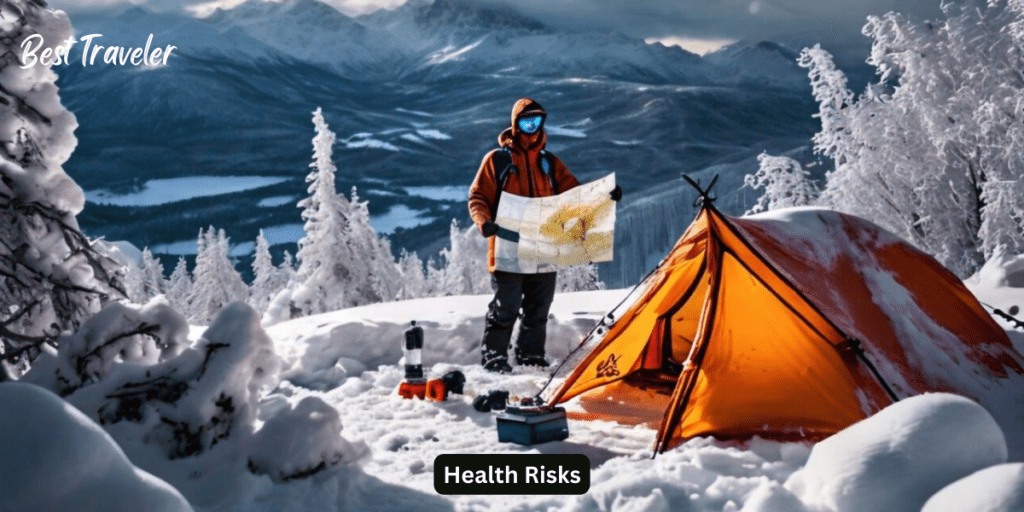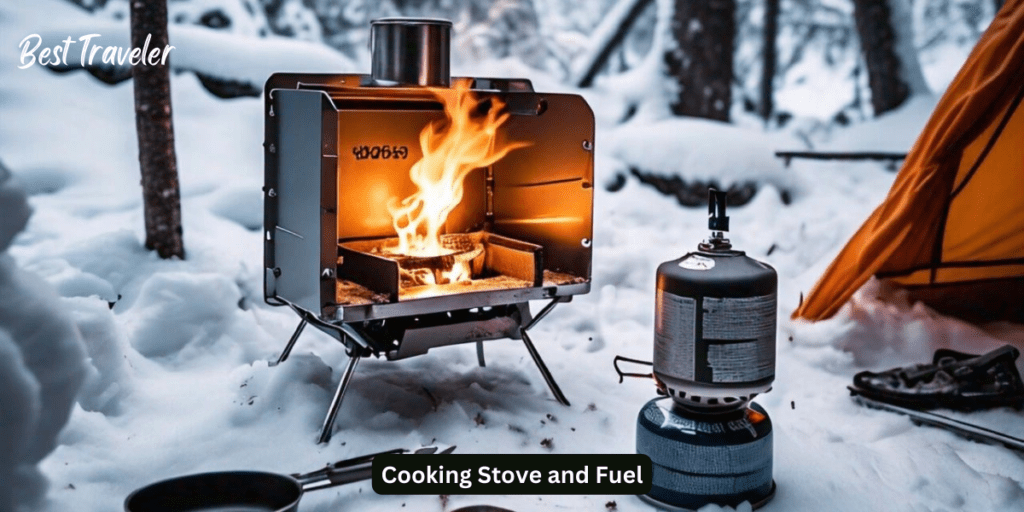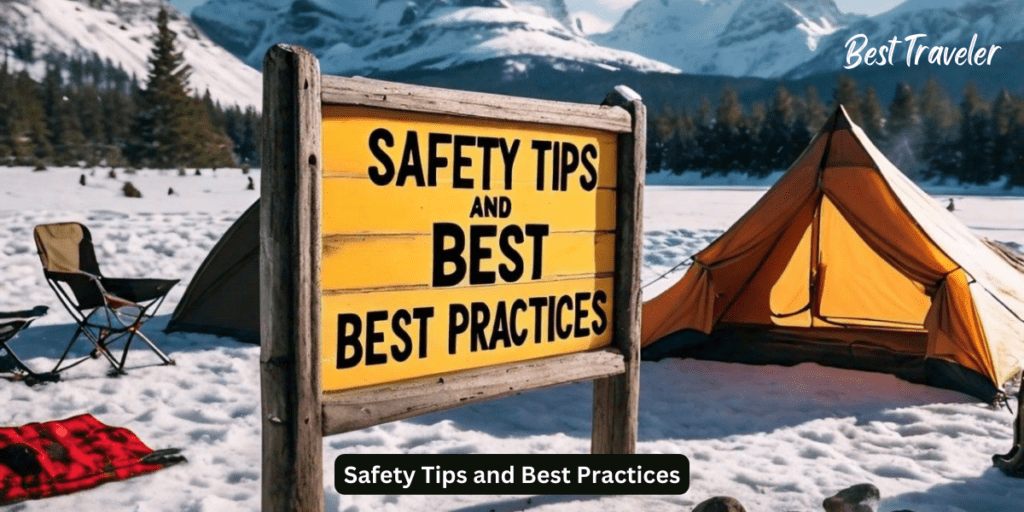Camping in snow can be an exhilarating and memorable experience, offering breathtaking landscapes and a unique connection with nature. However, it also presents a set of risks and challenges that campers need to be aware of and prepared for.
In this comprehensive guide, we’ll delve into the various dangers associated with camping in snow, from environmental hazards to health concerns, and discuss strategies for mitigating these risks to ensure a safe and enjoyable outdoor adventure.
Environmental Hazards

Snow camping exposes outdoor enthusiasts to a range of environmental hazards that can pose serious risks to their safety.
Snowfall and Avalanche
Snowfall and avalanches pose significant risks to campers in snowy environments. Heavy snowfall can create unstable snowpacks, increasing the likelihood of avalanches, especially in mountainous regions. Avalanches are sudden and powerful movements of snow, ice, and debris down a slope, capable of burying anything and anyone in their path.
Avalanche risk is influenced by various factors, including the type and stability of the snowpack, slope angle, terrain features, and weather conditions. Campers need to be aware of avalanche-prone areas and take precautions to avoid them, such as choosing safe campsites away from steep slopes and avalanche paths. Additionally, they should closely monitor weather forecasts and avalanche bulletins to assess the current avalanche danger level and make informed decisions about their route and camping location.
In avalanche terrain, campers should travel one at a time, maintain proper spacing between group members, and carry essential avalanche safety gear, including an avalanche beacon, probe, and shovel. Proper training in avalanche awareness and rescue techniques is crucial for all members of the camping party to effectively respond to an avalanche emergency.
Slippery Surfaces

Slippery surfaces present a common yet often underestimated risk for campers in snowy environments. Snow and ice-covered terrain can become treacherous, increasing the likelihood of slips, falls, and injuries. Whether hiking to a camping spot or simply navigating around the campsite, campers must be mindful of the slippery conditions and take precautions to prevent accidents.
The slick surfaces created by snow and ice can challenge even the most experienced outdoor enthusiasts. Uneven terrain, hidden obstacles, and changes in elevation further compound the risk, making it essential for campers to exercise caution and maintain balance while moving around.
To mitigate the risk of slips and falls, campers should wear appropriate footwear with sturdy treads and good traction to provide grip on slippery surfaces. Additionally, using trekking poles or walking sticks can enhance stability and help prevent falls, especially when traversing steep or icy terrain.
When setting up camp, choosing a flat and stable surface free from ice and snow can minimize the risk of accidents. Clearing away snow and creating a level area for tents and other equipment can provide a safer camping environment. Furthermore, placing traction aids such as traction mats or stakes around the campsite can improve footing and reduce the likelihood of slips and falls.
Health Risks

In addition to environmental hazards, camping in snow can also pose various health risks that campers need to be aware of and prepared.
Hypothermia
Hypothermia is a serious health risk that campers face when venturing into snowy environments. It occurs when the body loses heat faster than it can produce it, causing a dangerously low core body temperature. Cold temperatures, wind, wet clothing, and exhaustion can all contribute to the onset of hypothermia, making it essential for campers to recognize the signs and take preventive measures.
Early symptoms of hypothermia include shivering, confusion, numbness, and fatigue. As the condition progresses, individuals may experience slurred speech, clumsiness, and a decline in mental function. Severe hypothermia can lead to loss of consciousness, cardiac arrest, and even death if left untreated.
Camping in snow amplifies the risk of hypothermia due to the prolonged exposure to cold temperatures and wet conditions. Melting snow for drinking water, crossing icy streams, or simply being caught in a sudden snowstorm can all contribute to damp clothing and increased heat loss from the body.
To prevent hypothermia, campers should dress in layers of clothing to trap heat close to the body and wick moisture away from the skin. Synthetic or wool materials are preferred over cotton, as they retain warmth even when wet. Additionally, wearing a waterproof and windproof outer layer can provide added protection against the elements.
Staying dry is crucial for preventing hypothermia, so campers should change out of wet clothing promptly and seek shelter from rain, snow, and wind whenever possible. Using insulated sleeping bags and sleeping pads to provide insulation from the frozen ground can also help maintain body heat while sleeping.
Altitude Sickness

Altitude sickness is a common concern for campers exploring snowy environments at higher elevations. As altitude increases, the air becomes thinner, containing less oxygen, which can lead to a range of symptoms collectively known as altitude sickness or acute mountain sickness (AMS).
Symptoms of altitude sickness typically appear within hours to days of ascending to higher elevations and may include headache, nausea, fatigue, dizziness, and shortness of breath. In severe cases, altitude sickness can progress to more serious conditions such as high-altitude cerebral edema (HACE) or high-altitude pulmonary edema (HAPE), which require immediate medical attention.
Camping in snow often involves ascending to higher elevations, whether trekking through mountainous terrain or setting up camp in alpine environments. As such, campers need to be aware of the risks associated with altitude sickness and take preventive measures to minimize their chances of experiencing symptoms.
One of the most effective ways to prevent altitude sickness is to acclimatize gradually to higher elevations. This involves allowing the body time to adjust to the decreased oxygen levels by ascending slowly and spending additional nights at intermediate altitudes to allow for adaptation.
Staying hydrated is crucial for preventing altitude sickness, as dehydration can exacerbate symptoms. Campers should drink plenty of fluids, avoiding alcohol and caffeine, which can contribute to dehydration. Eating small, frequent meals rich in carbohydrates can also help provide energy and maintain blood oxygen levels.
Equipment and Gear

Proper equipment and gear are essential for staying safe and comfortable while camping in snow.
Sleeping Bag and Pad
Choosing the right sleeping bag and sleeping pad is crucial for staying warm and comfortable while camping in snow. In cold environments, proper insulation from the frozen ground and surrounding air is essential to prevent heat loss and maintain a comfortable sleeping temperature throughout the night.
A high-quality sleeping bag rated for cold temperatures is a must-have item for snow camping. Look for a sleeping bag with a temperature rating suitable for the expected conditions, typically indicated by its comfort rating (the lowest temperature at which an average person will feel comfortable) and its lower limit rating (the lowest temperature at which a cold sleeper will remain comfortable). Down-filled sleeping bags are lightweight and highly compressible, making them ideal for backpacking, while synthetic-filled sleeping bags offer better insulation when wet and are more affordable.
Pairing your sleeping bag with a suitable sleeping pad is equally important for insulation and comfort. The sleeping pad provides a barrier between your body and the cold ground, reducing heat loss through conduction and providing cushioning for a better night’s sleep. In snowy environments, where the ground can be frozen and unforgiving, a well-insulated sleeping pad is essential for staying warm and comfortable.
Opt for a sleeping pad with a high R-value, which measures its thermal resistance and insulation properties. The higher the R-value, the better the pad insulates against the cold ground. In cold conditions, choose a sleeping pad with an R-value of 3 or higher to provide adequate insulation from the snow and ice below.
Inflatable sleeping pads offer excellent insulation and comfort while remaining lightweight and compact for easy transport. Look for models with internal insulation, such as down or synthetic fibers, to enhance warmth without adding bulk. Additionally, consider using a closed-cell foam pad or a combination of foam and inflatable pads for added insulation and durability in extreme cold.
When setting up camp in snow, be sure to clear away any sharp objects or debris that could puncture your sleeping pad and compromise its insulation properties. Position your sleeping pad on a flat and level surface to ensure maximum contact with the ground and minimize heat loss. Finally, always store your sleeping bag and pad in a dry and uncompressed state to maintain their loft and insulation efficiency for future use.
Cooking Stove and Fuel

A reliable cooking stove and sufficient fuel are essential components of any snow camping adventure, providing warmth, nourishment, and comfort in cold and snowy conditions. Choosing the right stove and fuel options can significantly impact the efficiency and safety of meal preparation while camping in snow.
When selecting a cooking stove for snow camping, consider factors such as fuel type, stove design, and performance in cold weather. Liquid-fuel stoves, such as white gas or multi-fuel models, are preferred for winter camping due to their ability to operate in freezing temperatures and high altitudes. These stoves offer reliable performance and can burn a variety of liquid fuels, including white gas, kerosene, and unleaded gasoline, providing flexibility in remote and challenging environments.
Alternatively, canister stoves fueled by compressed gas can also be suitable for snow camping, especially in milder conditions or for short trips where weight and convenience are prioritized. However, canister stoves may struggle to maintain optimal performance in extremely cold temperatures, requiring preheating techniques or insulation to improve fuel efficiency.
When planning meals for snow camping, choose lightweight and energy-dense foods that are easy to prepare and provide essential nutrients and calories to fuel outdoor activities. Consider options such as dehydrated meals, instant soups, oatmeal, energy bars, and nuts, which require minimal cooking and can be quickly rehydrated with hot water from the stove.
Safety Tips and Best Practices

In addition to having the right gear, campers should follow these safety tips and best practices to reduce the risks associated with camping in snow.
Stay Warm and Dry
Staying warm and dry is paramount for the well-being and comfort of campers in snowy environments. Exposure to cold and wet conditions can lead to hypothermia, frostbite, and other cold-related injuries, making it essential to prioritize warmth and dryness while camping in snow.
To stay warm and dry, campers should dress in layers of clothing designed to trap heat close to the body and wick moisture away from the skin. Start with a moisture-wicking base layer to keep sweat away from the skin, followed by insulating mid-layers to retain body heat, and finish with a waterproof and windproof outer layer to protect against snow and moisture. Insulated hats, gloves, and socks are essential for keeping extremities warm and preventing heat loss.
Choose clothing made from synthetic or wool materials, as they retain warmth even when wet and dry quickly, unlike cotton, which can absorb moisture and lead to chilling. Pack extra clothing layers to change into if clothing becomes damp or wet, and avoid overdressing, which can lead to sweating and subsequent heat loss.
In addition to dressing appropriately, campers should take proactive measures to stay dry while camping in snow. Set up camp in a sheltered location away from potential sources of moisture, such as streams, lakes, or melting snow. Use a waterproof and durable tent with a rainfly to provide protection from snow, rain, and wind, and ensure the tent is properly pitched and sealed to prevent leaks.
When venturing outside the tent, wear waterproof and insulated footwear with good traction to prevent slips and keep feet warm and dry. Use waterproof gaiters to seal the gap between pants and boots and prevent snow from entering footwear. Carry a lightweight and compact umbrella or poncho for added protection during snowfall or inclement weather.
Use Navigation Aids

Navigation aids play a crucial role in ensuring campers’ safety and success while navigating snowy environments. In these conditions, where landmarks may be obscured by snow and visibility can be limited, reliable navigation tools are essential for staying on course and avoiding getting lost.
Carrying a map and compass or a GPS device is essential for navigating in snow-covered terrain, especially in remote or unfamiliar areas. A topographic map provides valuable information about the surrounding landscape, including elevation changes, terrain features, and landmarks, allowing campers to plan their route and identify potential hazards.
A compass is an essential tool for determining direction and orienting the map to match the surrounding terrain. By taking bearings to prominent landmarks or map features, campers can establish their position and navigate with confidence, even in low visibility conditions such as fog or snowstorms.
Alternatively, a GPS device provides real-time location information and navigation assistance, making it easier to track progress and follow a predetermined route. GPS devices offer additional features such as waypoints, tracks, and route planning, allowing campers to customize their navigation experience and adapt to changing conditions.
When using navigation aids in snowy environments, it’s essential to familiarize yourself with their operation and practice using them before setting out on your camping trip. Learn how to read a map and interpret contour lines, symbols, and scale to understand the terrain and plan your route effectively.
In addition to carrying navigation aids, campers should also use natural navigation cues, such as mountain peaks, ridgelines, and tree formations, to orient themselves and confirm their position. Pay attention to changes in terrain and landmarks to stay on track and avoid unnecessary detours or backtracking.
Regularly check your position on the map or GPS device to ensure you’re following the intended route and make adjustments as needed to avoid obstacles or hazards. Communicate with your camping partners and share navigation responsibilities to ensure everyone is on the same page and aware of the route plan.
By using navigation aids effectively and relying on a combination of map and compass skills, GPS technology, and natural navigation cues, campers can navigate snowy environments with confidence and reach their destination safely. Stay oriented, stay informed, and stay on course to make the most of your snowy camping adventure.
Conclusion & Recap
Camping in snow offers a unique opportunity to experience the beauty and tranquility of winter landscapes, but it also presents a set of risks and challenges that must be taken seriously. From environmental hazards like extreme cold and avalanches to health risks such as hypothermia and dehydration, snow camping requires careful planning, preparation, and risk management.
In this guide, we’ve explored the various dangers associated with camping in snow and discussed strategies for mitigating these risks, from choosing the right gear and equipment to following safety tips and best practices. By being well-prepared, staying informed, and exercising caution, campers can enjoy a safe and memorable outdoor adventure even in the harshest winter conditions.
Frequently Asked Questions
What should I wear when camping in snow?
Dressing appropriately for snow camping is crucial for staying warm and comfortable. Wear moisture-wicking base layers, insulating mid-layers, and waterproof outer layers to trap heat and keep out moisture. Don’t forget to cover extremities with insulated hats, gloves, and socks, and choose waterproof and insulated footwear with good traction to prevent slips.
How do I prevent hypothermia while camping in snow?
Hypothermia is a serious risk in snowy environments, so it’s essential to stay warm and dry. Dress in layers, stay hydrated, eat high-energy foods, and avoid prolonged exposure to cold and wet conditions. Change out of wet clothing promptly, seek shelter from wind and precipitation, and carry emergency supplies such as blankets and heat packs.
What safety precautions should I take when camping in avalanche terrain?
Camping in avalanche-prone areas requires careful planning and risk management. Avoid camping in or below avalanche paths, choose safe routes and campsites away from steep slopes, and monitor avalanche forecasts and bulletins. Carry essential avalanche safety gear, including beacons, probes, and shovels, and practice avalanche rescue techniques with your camping partners.
How can I stay hydrated while camping in snow?
Staying hydrated is crucial for maintaining body temperature and preventing cold-related injuries. Drink plenty of fluids throughout the day, even if you don’t feel thirsty, and avoid alcohol and caffeine, which can contribute to dehydration. Consider melting snow for drinking water using a stove or water purification system, and carry a sufficient supply of fluids for the duration of your trip.
What navigation aids should I use when camping in snow?
Navigation aids such as maps, compasses, and GPS devices are essential for navigating snowy environments. Carry a topographic map and compass to plan your route and determine your position, and consider using a GPS device for real-time location tracking and navigation assistance. Familiarize yourself with the operation of your navigation tools and practice using them before your camping trip to ensure confidence and competence in navigating snow-covered terrain.

